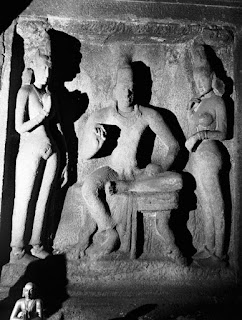The Pallava Dynasty
Pallava Dynasty
The Pallava Dynasty rose to Prominence in South India from early 4th century to Late 9th century. Their Origins were said to be from the subordinates of Satavahana Dynasty in the Deccan, They made Kanchipuram in Tamil Nadu as their capital .They were able to consolidate their power for around 500 years!!
Pallava Kings were great Patrons of Culture, Art, Architecture and Literature. They Built great cities such as Kanchi, Mahabalipuram etc, Centers of Learnings ,Temples such as Kailasnathar Temple in Kanchipuram and Shore Temple in Mahabalipuram .
Pallavas had a Great influence in the South Asia From Ceylon to Indonesia, Malay Peninsula and Cambodia. Their Territory extended from northern part of Andhra Pradesh to Kaveri River in the South during the peak of the empire. It was Pallavas under whom the Cholas were Reduced to a Marginal state in 7th Century.
Simhavarman/Simhavishnu (Reign: 575 AD – 600 AD)
The Start of Significant Rule of Pallava Sovereign state was attributed to Simhavishnu. He was first Pallava Monarch to extend the empire beyond Kanchipuram in the South. He reigned from circa 575 CE to 600 CE and stands out among the many rulers of the dynasty for his adherence to Buddhism.
Kanchipuram was near the coast of the Bay of Bengal . Kanchipuram grew into a center of scholarship and arts , Hindu architectural features into its buildings and is home to one of the Pallava Dynasty's great architectural contributions, the Kailasanathar Temple which is dedicated to the Hindu god Shiva. The Pallava Dynasty controlled much of the southeastern coast of India they also were skilled seafarers.
Kailasanathar Temple
Mahendravarman (Reign: 600 AD – 630 AD)
Mahendravarman I contributed to the greatness of the Pallava dynasty. He was the son of Simhavishnu, who defeated the Kalabhras and re-established the Pallava kingdom .
Some of the most ornate monuments at Mamallapuram, especially those dedicated to the Hindu god Shiva, were constructed under his rule. He built five-celled cave temple at Pallavaram, the Kokarneswarar Temple, and Thirukokarnam of Pudukottai, Tamil Nadu.
He was initially a patron of the Jain faith but under the influence of the Saiva saint Appar patronised the Saiva faith. Tamil literature flourished under his rule, with the rise in popularity of Tevaram written by Appar and Sambandhar. He was the author of the play Mattavilasa Prahasana and another play called Bhagavadajjuka.
Had on-going rivalry and battles with Pulakesin II of Chalukya dynasty. Mahendravarman died in battle with the Chalukyas. He was an able and efficient ruler.
Narasimhavarman I (630 AD – 668 AD)
He was Son and successor of Mahendravarman. Considered the greatest of the Pallavas. Also called Narasimhavarman Mahamalla/Mamalla.
Defeated and killed Pulakesin II in 642 AD. He took control of Vatapi, the Chalukya capital and assumed the title ‘Vatapikonda’.Also vanquished the Cholas, Cheras and the Pandyas.
He sent a naval expedition to Sri Lanka and reinstated the Sinhalese Prince Manivarma.
He was also known as Mamallan (great wrestler), and Mamallapuram (Mahabalipuram) was named after him.He shared his father Mahendravarman I's love of art and completed the work started by Mahendravarman in Mamallapuram. Hiuen Tsang visited the Pallava kingdom during his reign in about 640 AD and he describes the people living in his kingdom as happy. There was an abundance of agricultural products.
Great Nayannar saints like Appar, Tirugnanasambandar and Siruthondar lived during his reign.
He was succeeded by his son Mahendravarman II who ruled from 668 to 670 AD.
After Mahendravarman II, his son Parameswaravarman became the king.
Narasimhavarman II
He was one of the greatest rulers of Pallavas like Mahendravarman I and Narasimhavarman I.
He constructed the Shore Temple, Isvara and Mukunda Temples in Mahabalipuram, the Panamalai Temple in South Arcot, plus the Kailasanathar Temple and Vaikuntha-Perumal Temples in Kanchipuram. He was a great devotee of Shiva and constructed the Kailasanathar Temple at Kanchipuram.
Writing System
Under the Pallava dynasty, a unique form of Grantha script, a descendant of Pallava script which is a type of Brahmic script, was used. Around the 6th century, it was exported eastwards and influenced the genesis of almost all Southeast Asian scripts.
Architecture During Pallava
The Pallavas were instrumental in the transition from rock-cut architecture to stone temples. The earliest examples of Pallava constructions are rock-cut temples dating from 610 to 690 and structural temples between 690 and 900. A number of rock-cut cave temples bear the inscription of the Pallava king, Mahendravarman I and his successors.
By :- Varad Udgirkar
References:
https://www.britannica.com/topic/Pallava-dynasty
https://www.jagranjosh.com/general-knowledge/list-of-pallavas-rulers-of-kanchipuram-and-their-contributions-1508840278-1
https://byjus.com/free-ias-prep/ncert-notes-pallavas-origins-rulers/
https://study.com/academy/lesson/pallava-dynasty-history-founder.html
https://en.wikipedia.org/wiki/Pallava_dynasty
Image Credits:
Shreyans69, CC BY-SA 4.0 <https://creativecommons.org/licenses/by-sa/4.0>, via Wikimedia Commons
Keshav Mukund Kandhadai, CC BY 2.0 <https://creativecommons.org/licenses/by/2.0>, via Wikimedia Commons
CC BY-SA 3.0, https://commons.wikimedia.org/w/index.php?curid=399504
By Venu62 - Venu62 in en:WP (Mamallapuram.jpg), CC BY-SA 3.0, https://commons.wikimedia.org/w/index.php?curid=2688990
NOTE :-
This blog is meant for Educational Purpose only .We do not own any Copyrights related to images and information , all the rights goes to their respective owners . The sole purpose of this blog is to Educate, Inspire, Empower and to create awareness in the viewers. The usage is non-commercial(Not For Profit) and we do not make any money from it.







Comments
Post a Comment